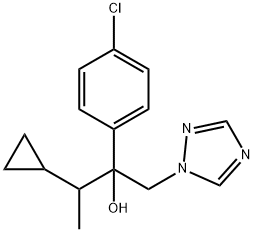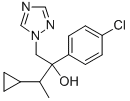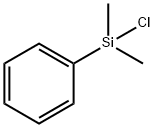Cyproconazole
- CAS NO.:94361-06-5
- Empirical Formula: C15H18ClN3O
- Molecular Weight: 291.78
- MDL number: MFCD01678672
- EINECS: 619-020-1
- SAFETY DATA SHEET (SDS)
- Update Date: 2024-12-18 14:08:52

What is Cyproconazole?
Chemical properties
Colorless, crystalline solid. Odorless.
The Uses of Cyproconazole
Cyproconazole is a fungicide treatment for wood preservative that prevents decay from fungi in above-ground applications.
The Uses of Cyproconazole
Cyproconazole is used to inhibit demeythylation in fungal sterol synthesis. And it is used on greenhouse and field-grown roses and as a wood preservative, surface application or pressure treatment of wood for above-ground uses, including siding, plywood, millwork, shingles, lumber.
The Uses of Cyproconazole
Cyproconazole is used as a systemic fungicide to control cereal and sugar beet foliar diseases: Septoria, rust, powdery mildew, Rhyncosporium, Cercospora and Ramularia. It is also used in fruit trees, vines, coffee, banana, turf, and vegetables to control Venturia, powdery mildew, rust, Mycosphaerela, Monilia, Mycena, Sclerotinia and Rhizoctonia.
What are the applications of Application
Cyproconazole is a triazole fungicide
Definition
ChEBI: 2-(4-chlorophenyl)-3-cyclopropyl-1-(1H-1,2,4-triazol-1-yl)butan-2-ol is a tertiary alcohol that is butan-2-ol substituted by a 4-chlorophenyl group at position 2, a cyclopropyl group at position 3 and a 1H-1,2,4-triazol-1-yl group at position 1. It is a member of monochlorobenzenes, a tertiary alcohol, a member of triazoles and a member of cyclopropanes.
Agricultural Uses
Fungicide: Used to control fungus on cereals, coffee beans; anthracnose and other diseases on turfgrass; used against rust and leaf spot disease.
Trade name
ALTO®; ALTO®, ELITE; ATEMI®; ATEMI-50-SL®;EVIPOL®; FLINT®; NOAH GOLD®; SAN-619 F®; SENTINEL®; SN 108266®
Potential Exposure
Triazole fungicide used to control fun- gus on cereals, coffee beans; anthracnose and other diseases on turfgrass; used against rust and leaf spot disease.
Metabolic pathway
Cyproconazole is a mixture of diastereiosomers and the preferential mammalian metabolism of one isomer has been observed. Pathways of metabolism in plants and mammals are quite similar. Metabolism primarily involves oxidation of the terminal methyl group to alcohols and carboxylic acids and/or hydroxylation at the 3-position. Loss of the alkyl cyclopropyl moiety or the triazolyl ring also occurs.
Shipping
UN3082 Environmentally hazardous substances, liquid, n.o.s., Hazard class: 9; Labels: 9-Miscellaneous haz- ardous material, Technical Name Required
Degradation
Cyproconazole is stable and decomposition was <5% after 2 years. It
was stable in aqueous solutions (at pH 1-9) for 35 days (50 °C) or 14
days (80 °C). It is slowly hydrolysed in hydrochloric acid or sodium
hydroxide.
14C-Labelled cyproconazole was applied at a rate equivalent to
100 g ha-1 to the surface of a 2 mm layer of loam soil. The samples were
exposed to natural sunlight for up to 72 days on open dishes or in flasks
fitted with plugs to trap volatile products. Samples were extracted at
intervals and analysed. After 37 days exposure on dishes, 50% of the
applied cyproconazole remained whereas 85% remained after 72 days in
the flasks. In the dishes, unextractable residues amounted to 13-20% of
the applied radiolabel after 20 days or more exposure, whereas in the
flasks it reached a maximum of 6% after 15 days. The products identified
in the dishes were: 1-(4-chlorophenyl)-2-(1H -1,2,4-triazol-l-yl)-
ethanone (2, 5%), 3-cyclopropyl-1-(1H-1,2,4-triazol-l-yl)butanone(4,4%),
2-(2- or 3-hydroxy-4-chlorophenyl)-3-cyclopropyl-1-(1H -1,2,4-triazol-1-yl)-
butan-2-ol (3 4%), and 4-chlorobenzoic acid 5 (Scheme 1) (PSD, 1991).
Degradation in the flasks was similar but occurred to a lesser extent. No
volatde products were trapped and recoveries of radiolabel were 94-
102%.
Incompatibilities
The triazoles are sensitive to heat, fric- tion, and impact. Sensitivity varies with the type substitu- tion to the triazole ring. Metal chelated and halogen substitution of the triazol ring make for a particularly heat sensitive material. Azido and nitro derivatives have been employed as high explosives. No matter the derivative these materials should be treated as explosives .
Waste Disposal
Consult with environmental regulatory agencies for guidance on acceptable disposal practices. Contact a licensed disposal facility about surplus and nonrecyclable solutions. Burn in a chemical incinerator equipped with an afterburner and scrubber. Extra care must be exercised as the material in an organic solvent is highly flammable. In accordance with 40CFR165, follow recom- mendations for the disposal of pesticides and pesticide con- tainers. Containers must be disposed of properly by following package label directions or by contacting your local or federal environmental control agency, or by con- tacting your regional EPA office. Incineration or permanga- nate oxidation.
Properties of Cyproconazole
| Melting point: | 108℃ |
| Boiling point: | >250℃ |
| Density | 1.32 |
| vapor pressure | 3.46 x l0-5 Pa (20 °C) |
| refractive index | 1.6330 (estimate) |
| Flash point: | >100 °C |
| storage temp. | Store at -20°C |
| solubility | Soluble in acetone, ethanol, xylene, and dimethyl sulfoxide. |
| form | neat |
| Water Solubility | 140 mg l-1(25 °C) |
| form | Solid |
| pka | 12.59±0.29(Predicted) |
| color | White to off-white |
| BRN | 8396421 |
| Stability: | Hygroscopic |
| CAS DataBase Reference | 94361-06-5(CAS DataBase Reference) |
| EPA Substance Registry System | Cyproconazole (94361-06-5) |
Safety information for Cyproconazole
| Signal word | Danger |
| Pictogram(s) |
 Skull and Crossbones Acute Toxicity GHS06  Health Hazard GHS08  Environment GHS09 |
| GHS Hazard Statements |
H301:Acute toxicity,oral H373:Specific target organ toxicity, repeated exposure H410:Hazardous to the aquatic environment, long-term hazard |
| Precautionary Statement Codes |
P201:Obtain special instructions before use. P202:Do not handle until all safety precautions have been read and understood. P260:Do not breathe dust/fume/gas/mist/vapours/spray. P264:Wash hands thoroughly after handling. P264:Wash skin thouroughly after handling. P273:Avoid release to the environment. P301+P310:IF SWALLOWED: Immediately call a POISON CENTER or doctor/physician. |
Computed Descriptors for Cyproconazole
New Products
(S)-3-Aminobutanenitrile hydrochloride 4-Methylphenylacetic acid N-Boc-D-alaninol N-BOC-D/L-ALANINOL Tert-butyl bis(2-chloroethyl)carbamate 3-Morpholino-1-(4-nitrophenyl)-5,6-dihydropyridin- 2(1H)-one Furan-2,5-Dicarboxylic Acid Tropic acid 1-Bromo-3,5-Di-Tert-Butylbenzene S-2-CHLORO PROPIONIC ACID ETHYL ISOCYANOACETATE 2-Bromo-1,3-Bis(Dimethylamino)Trimethinium Hexafluorophosphate 4-IODO BENZOIC ACID 3-NITRO-2-METHYL ANILINE 1-(2,4-DICHLOROPHENYL) ETHANAMINE (2-Hydroxyphenyl)acetonitrile 4-Bromopyrazole 2-(Cyanocyclohexyl)acetic acid 4-methoxy-3,5-dinitropyridine 1-(4-(aminomethyl)benzyl)urea hydrochloride 2-aminopropyl benzoate hydrochloride diethyl 2-(2-((tertbutoxycarbonyl)amino) ethyl)malonate tert-butyl 4- (ureidomethyl)benzylcarbamate Ethyl-2-chloro((4-methoxyphenyl)hydrazono)acetateRelated products of tetrahydrofuran

![4-CYPROCONAZOLE, [METHYL-14C]-](https://img.chemicalbook.in/StructureFile/ChemBookStructure5/GIF/CB2735344.gif)






You may like
-
 Cyproconazole 95.00% CAS 94361-06-5View Details
Cyproconazole 95.00% CAS 94361-06-5View Details
94361-06-5 -
 Cyproconazol CAS 94361-06-5View Details
Cyproconazol CAS 94361-06-5View Details
94361-06-5 -
 Cyproconazol CAS 94361-06-5View Details
Cyproconazol CAS 94361-06-5View Details
94361-06-5 -
 1975-50-4 98%View Details
1975-50-4 98%View Details
1975-50-4 -
 2-HYDROXY BENZYL ALCOHOL 98%View Details
2-HYDROXY BENZYL ALCOHOL 98%View Details
90-01-7 -
 2-Chloro-1,3-Bis(Dimethylamino)Trimethinium Hexafluorophosphate 221615-75-4 98%View Details
2-Chloro-1,3-Bis(Dimethylamino)Trimethinium Hexafluorophosphate 221615-75-4 98%View Details
221615-75-4 -
 14714-50-2 (2-Hydroxyphenyl)acetonitrile 98+View Details
14714-50-2 (2-Hydroxyphenyl)acetonitrile 98+View Details
14714-50-2 -
 118753-70-1 98+View Details
118753-70-1 98+View Details
118753-70-1